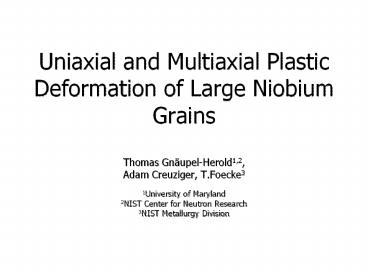Uniaxial and Multiaxial Plastic Deformation of Large Niobium Grains - PowerPoint PPT Presentation
Title:
Uniaxial and Multiaxial Plastic Deformation of Large Niobium Grains
Description:
Uniaxial and Multiaxial Plastic Deformation of Large Niobium Grains Thomas Gn upel-Herold1,2, Adam Creuziger, T.Foecke3 1University of Maryland – PowerPoint PPT presentation
Number of Views:84
Avg rating:3.0/5.0
Title: Uniaxial and Multiaxial Plastic Deformation of Large Niobium Grains
1
Uniaxial and Multiaxial Plastic Deformation of
Large Niobium Grains
- Thomas Gnäupel-Herold1,2,
- Adam Creuziger, T.Foecke3
- 1University of Maryland
- 2NIST Center for Neutron Research
- 3NIST Metallurgy Division
2
Formability strain localization on grain
boundaries
up to 0.5 mm displacement found between
neighboring grains
3
Plastic Properties of Niobium
BCC Crystal Structure
lt 111 gt slip direction (close-packed
direction) Any plane containing lt 111 gt is a
potential slip plane Experimentally observed in
(110), (112) (123) planes
4
Tensile TestsOrientations
5
Tensile Tests
6
Yield Stress
- YS between 25 MPa and 40 MPa
- weak anisotropy
- 25 YS of poly-crystal
Polycrystal
Single crystal
7
R-Values
- Extreme anisotropy from r0 (thinning only) to
rgt1 (no thinning) - Polycrystal r0.1
- Large r-values for 210lt-120gt
8
Effect of Annealing
- Yield stress and yield drop increase with
annealing temperature
9
Sample prep for multiaxial tests
10
Multi-axial Testing
11
A - Uniaxial Test
12
B - Uniaxial Test, 90 deg rotated
13
C - Balanced Biaxial Test
14
D - Plane Strain
localization
15
E - Plane Strain, 90 deg. rotated
16
E Plane Strain
17
EBSD Misorientations at the tri-junction
- Slip lines and small-angle grain boundaries
- Diffuse slip, most likely from rapidly changing
strain gradients leading to succession of
activation/deactivation of localized slip systems
18
Analysis of present data
- What is known .
- Full strain rate tensor at every point on the
sample and in time - orientations
- What is needed
- Slip systems that are locally active at a given
point in time
19
Taylors model
- Imposed strain rate tensor
- Write the strain rate tensor as a combination of
all the slip systems
20
Conclusions
- 5 Multi-axial straining tests of tri-crystal
plates with identical orientation performed - Local strain rate data collected
- Orientation analysis with EBSD
- GOAL determination of locally active slip
systems for any given moment































